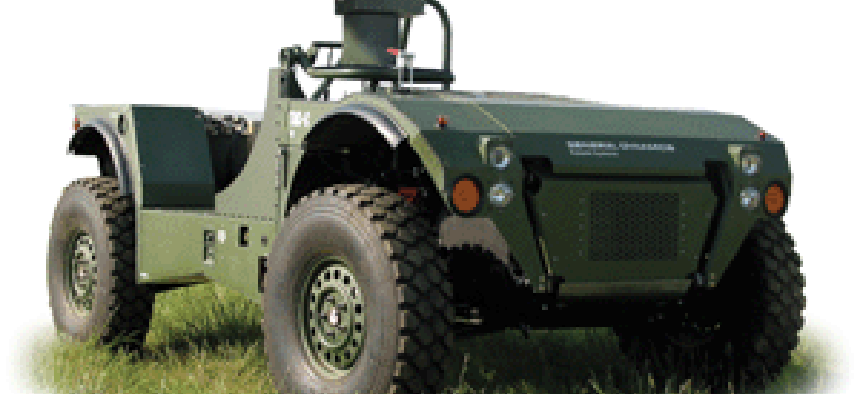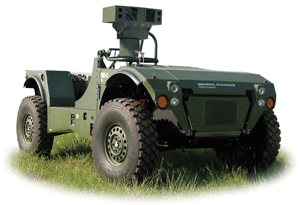'The time of robotics has arrived'

Rumbling along a dusty road in the Iraq desert, two dozen trucks are loaded with food and water for soldiers stationed in a remote town.
Rumbling along a dusty road in the Iraq desert, two dozen trucks are loaded with food and water for soldiers stationed in a remote town.An explosion erupts from a bomb hidden on the road and disintegrates the first truck. The convoy pauses for a few seconds, then calmly drives around the wreckage to complete the mission.No chaos erupts, because nobody has been hurt or killed. The convoy is all unmanned ground vehicles.Putting into action that kind of life-saving technology ? which is years from being deployed ? is one of the goals of the Defense Department's unmanned ground vehicles (UGV) program, said Army Research Laboratory Chief of Robotics Charles Shoemaker at a recent vehicle demonstration.To get there, the military and its contractors need to develop software, sensors and networking schemes that let vehicles operate autonomously.Using Stryker eight-wheeled armored vehicles, General Dynamics Corp. officials demonstrated the developing technology that, Shoemaker said, will let soldiers pay attention to their surroundings rather than their vehicles. The autonomous vehicles could be assigned a mission and deal with variables, all while keeping troops out of harms way.The demonstration was held in Westminster, Md., where General Dynamics broke ground recently on a 150,000-square-foot manufacturing facility where the unmanned machines someday will be built.EASY COME, EASY GOUnmanned aerial vehicles have been used in warfighting for years, and are widely deployed in Iraq and Afghanistan, but unmanned ground vehicles require more development, said Scott Myers, president of General Dynamics Robotic Systems."We're probably two to three years away, relative to where the unmanned aerial vehicles world is," Myers said. "In a lot of ways, the UAV world is easier because once the vehicles get above the ground, they don't worry about running into obstacles, for the most part."Safely operating unmanned vehicles on highways and in back country is one of the biggest challenges developers face, said Sebastian Thrun, director of Stanford University's Artificial Intelligence laboratory. Unlike flying vehicles, ground vehicles must contend with curbs, fences, boulders, ditches, other vehicles, pedestrians and countless other obstacles. The goal is for the vehicles to be mostly autonomous, which means they must rely on sensors and other systems to keep them safe."That's probably the biggest void in ground vehicles," Thrun said.This was made acutely apparent to researchers last year during a Defense Advanced Research Project Agency UGV event, called the Grand Challenge. The competition challenged UGVs to run from Barstow, Calif., to Primm, Nev., more than 100 miles, with a $1 million prize waiting for the winner. But the money went unclaimed ? none of the 15 finalists could complete the desert course.Another Grand Challenge is scheduled for October, and the prize has been boosted to $2 million. The route will be no more than 175 miles over desert terrain.Even with the latest technologies, the teams will not have an easy time completing the course, Thrun said. Sensors, such as lasers and radar, can have difficulty spotting obstacles if the contour of the terrain impedes line of sight. The faster the vehicle travels, the more difficult it becomes.A shift in the paradigm as to how UGVs avoid obstacles is an area ripe for research and could prove to be an attractive business opportunity for systems integrators and other technology companies."Instead of using those techniques, we need to turn toward techniques that have more of an intuitive feeling," Thrun said.For example, drivers on a highway mostly rely on driving between lane markers and maintaining a safe speed so they don't crash into the cars in front of them. Making UGV sensors think like that, rather than trying to scan the entire road surface several times a second, may be the answer.IT IS KEYIT is a big piece of UGV development and implementation, said Arthur Sanderson, vice president of research at Rensselaer Polytechnic Institute in Troy, N.Y."As we build and implement autonomous vehicles, particularly in the military framework, it is critical that the surrounding information infrastructure be available to integrate them to and execute the appropriate tasks," Sanderson said. "As they grow in their role in the military mission, that IT infrastructure will need to grow as well."In the United States, research and development on UGVs and robots focus mainly on the Defense Department. International efforts focus more on civilian applications, according to results of a study released this month.The International Study of Robotics Research, sponsored by NASA, the National Science Foundation and the National Institutes of Health, found that development of mobile robots in the European community concentrates on civilian and urban infrastructure, said George Bekey, a University of Southern California professor who participated in the study. In France, for example, research is being done on using robotics for urban transportation, Bekey said.ON GUARDMuch work remains in developing unmanned vehicles for the battlefield, but a joint Army-Navy project to develop UGVs to serve as facility guards is closer to reality.Northrop Grumman Corp. won a contract to develop a UGV under the Army's Family of Integrated Rapid Response Equipment program.Northrop's Tactical Amphibious Ground Support vehicle was selected to be the unmanned ground platform for the program, said Paul Cabellon, marketing communications manager for Northrop Grumman. The company's Remotec Inc. subsidiary won the contract.Northrop's portion of the $11.6 million UGV contract is $4.3 million to provide four vehicles to the Army, Cabellon said.The Tactical Amphibious Ground Support system is a tracked vehicle about the size of a compact car. It has a 60 horsepower, diesel-charged engine, can carry about 2,400 pounds and has a top speed of 25 mph."It's going to do surveillance for bases, stations, things like that," Cabellon said. "It is waypoint navigated autonomous, which means that the sensors aboard it allow it to steer along a predetermined path."The vehicles are in production and are to be deployed at bases in Iraq in fall 2006, Cabellon said.A similar system under development is the Mobile Detection Assessment and Response System, or MDARS. It will detect intrusions and assess inventory at warehouses and storage sites.General Dynamic's initial development and demonstration contract for MDARS is worth $17 million, a company official said.General Dynamics expects to start producing the vehicles in the next nine months, Myers said. In addition to patrolling for intruders and checking locks, the four-wheeled vehicle will have radio frequency identification tag readers onboard to check inventories."The time of robotics has arrived," said USC's Bekey. "You can see it in the commercial successes, you can see it in the robots on Mars, and you can see it in the international cooperatives that are developing it."Staff Writer Doug Beizer can be reached at dbeizer@postnewsweektech.com.


General Dynamics' Tactical Autonomous Combat-Chassis can be configured for multiple uses.
Courtesy of General Dynamics
NEXT STORY: Consolidation answers coming

